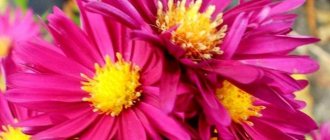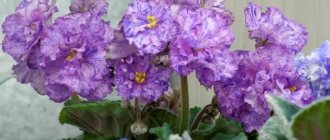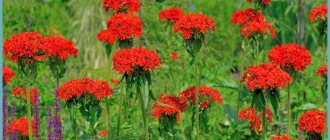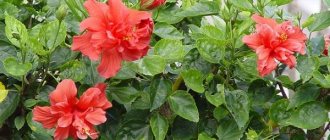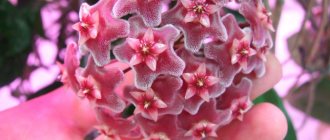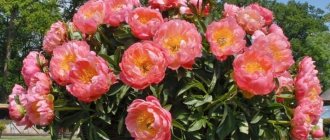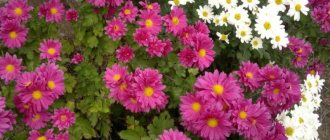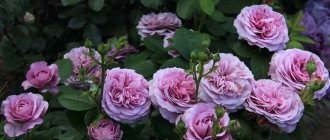Cornflower is a herbaceous annual or perennial with delicate flowers. The plant belongs to the Asteraceae family. The scientific name, centaurea, has been variously interpreted as “centaur flower” or “ox-stabbing.” It is known to almost everyone due to its wide distribution and impressive number of wild varieties.
Although the plant's homeland is Southern Europe, it can be found everywhere in temperate climates: in fields, in steppes. Cornflower is used in a variety of ways. They decorate the garden and are also used in medicine and cooking. In Rus', the plant was considered a powerful amulet against evil spells and was used by girls in rituals on the holiday of Ivan Kupala.
Description and features
The herbaceous plant of the Asteraceae family is interesting for its baskets of finely cut petals. The annual and perennial plant has a tall, erect stem reaching a height of 80-100 centimeters. The stem branches in the middle. Thin lanceolate leaves of cornflower are covered with hairs below.
Cornflower blooms all summer. During this period, the marginal asexual petals are colored blue, white, and red. In the middle of the basket they are tubular and dark purple.
The garden type of cornflower has a greater variety of colors than the field type. Breeders have developed varieties that have not only a simple flower, but also double and semi-double flowers.
If in the wild you have to fight cornflower like a weed, then in the garden bushes take their place in landscape design. It is interesting that the crop grows everywhere, as it is unpretentious to growing conditions, climate, and soil.
Preparation and sowing
This is what cornflower seeds look like.
When to start growing seedlings
In different regions, the timing of sowing flower crops varies. In places where the climate is warmer, in the south, you can sow seeds as early as mid-March, and in the cool northern regions, the optimal time will be the second ten days of April.
How to properly prepare a seed for sowing
Cornflower seeds have a high probability of germination. Still, it is better to buy planting material in specialized stores from a good manufacturer. Or use grains collected on your own plot.
There are no mandatory procedures associated with treating seeds before planting them as seedlings. To increase germination, you can soak them in a growth solution such as Zircon. The composition of the stimulant must be prepared strictly following the instructions from the manufacturer.
What soil is needed for sowing?
The soil for seedlings should be loose, nutritious and neutral. A universal mixture or soil for flower crops is perfect.
Which container to choose
Seedlings can be grown in plastic cups, garden cassettes, peat tablets and other single containers. It is preferable to sow each hairworm seed separately. There are several reasons for this:
- cornflower grains are very large;
- this is how seedlings grow and develop faster;
- cornflower does not tolerate transplantation well.
If, nevertheless, a decision is made to use large garden boxes, further manipulations with seedlings should be done very carefully so as not to damage the sprouts.
How to carry out sowing work
To grow cornflower seedlings from seeds, the following sowing algorithm is used:
- At the bottom of the sowing container, a drainage layer of at least 1.5 cm is laid. Perlite can be used for these purposes.
- The sowing container is filled with earth, but not to the very edge. It is necessary to leave a reserve, since another layer of soil will be laid later.
- In the center of the individual container is a flower seed. When using a common container, the grains are laid out at a distance of 3 cm.
- More soil is poured on top of the seeds in a thin layer. The top layer should be approximately 0.5 cm.
- The planted cornflower seeds are generously sprayed with settled warm water. Humidification is carried out only using a sprayer. Watering from a bottle or similar liquid containers is highly undesirable. This can have a detrimental effect on future plants.
- Each cup of seeds is covered with plastic wrap or a lid to create a greenhouse. Glass can be used for a garden box.
If peat tablets are used when growing cornflower seedlings, they should first be soaked in water. During planting, the seed is pushed inside with a wooden stick. There is no need to cover them with soil!
Kinds
Decorative perennials differ little in the structure of the inflorescence. The differences lie in the splendor of the petals, their color, and the height of the stem.
Blue
A plant with a branched, rough stem is considered a weed. It grows in Europe, especially likes to be in fields where cereals grow. Flower baskets with blue petals at the edges are wrapped in filmy plates laid in tiles. In the middle of the inflorescence there are tubular petals of a purple tone. It is this type of cornflower that is used for medicinal purposes.
White
A rare species of cornflower is listed in the Red Book. It is found in the wild in the mountainous areas of the Caucasus, Iran. Dense bushes with a height of 30 to 55 centimeters have dissected leaves. The leaf blades are dark green above and whitish below. The diameter of the inflorescences reaches 4 centimeters.
Mountain
This type of herbaceous plant is found in the mountains of Western Europe. The flower has an erect stem without lateral branches, the height of which is from 30 to 70 centimeters. Whole leaves of lanceolate type are collected in a basal rosette. The stem is crowned with a basket with an inflorescence diameter of 6 centimeters. Externally, mountain cornflower is similar to blue cornflower, but it is a perennial herb, unlike field grass.
Yellow
The bright yellow inflorescences of the plant are quite large, up to 7 centimeters in diameter. The perennial blooms from July to August. It can become a decoration of the site thanks to its lush bushes. In nature, yellow cornflower is found in the territory from the Urals to the Far East.
Large-headed
The cornflower is called Grossheimia macrocapitatum. The inflorescences have the shape of a ball, they are large, and the bottom is wrapped in scales of green plates. Cut flowers last a long time and can become a decoration for a room.
Oriental
For a perennial:
- short rhizome;
- hairy stem 40-90 centimeters high;
- pinnately divided leaves on long petioles;
- a basket of inflorescences with a diameter of 3 centimeters;
- intense yellow color of the corolla.
The species grows across the steppes, reproducing by seeds.
Lugovoy
The weed is found along roadsides and forest edges. Lilac-pink inflorescences-baskets consist of 2 types of flowers. The edges of the petals are asexual, funnel-like. In the center are modest tubular ones, which are needed for cornflower propagation.
Field
The herbaceous annual or biennial is used medicinally. Its blue or blue heads are found in fields sown with cereal crops. As the weed grows, it destroys part of the crop. Cornflower is actively used in folk medicine.
Whitened
The flower is famous for the beauty of its petals and leaves. Bright pink flowers sit solitary on tall stems. The basal leaves are collected in a rosette. The plates are green on top and covered with whitish felt underneath. Designers value cornflower for the neatness of the bush, its sphericity and silvery shades.
Spreading
The plant's stem branches at the very base. The bush is distinguished by small baskets of flowers. The color of the petals is pale pink or white. Cornflower is a biennial crop and blooms from June to autumn. It grows abundantly in vacant lots, near railroads, and near highways.
Pink
The perennial reaches a height of one meter. Large flowers of rich pink color appear on top. A special feature is the swelling of the stems under the inflorescences.
American
An ornamental cold-resistant species grows in the prairies of North America. On erect stems 1 meter high there are single flowers with a diameter of up to 8-10 centimeters. The color of the petals is pale lilac.
Sowing
Blue cornflower is a sowing species. It tolerates wintering well and is easy to care for.
Mountain cornflower: description
Mountain cornflower is a long plant with erect shoots topped with single flowers with a diameter of 6-8.5 cm. If you look closely, you can easily notice the structure of the inflorescence. This is a basket, along the edges of which there are large funnel-shaped and small tubular flowers.
They are wrapped underneath in a wrapper of several sequences of fringed leaves.
Mountain cornflower blooms for about 2 months, starting in June.
Varieties:
- Alba, a low plant with white flowers.
- Parham (purple).
- Grandiflora with light blue flowers up to 8 cm in diameter.
- Rosea has pink flowers.
- Violetta with dark purple flowers.
The homeland of the mountain cornflower is the Western European mountains. Based on this, he is adapted to negative conditions. strong wind and scorching sun are not scary for this plant. The branched root, penetrating into the ground to a depth of 10 cm, helps to stay firmly in the ground.
It is formed in a horizontal plane and increases by 5-6 cm per year.
Mountain cornflower is valued for its beautiful flowers and decorative whole leaves with white edges.
They grow intensively in the spring. By the end of summer they slowly fall off, but the plant does not lose its attractiveness. Instead of fallen leaves, new ones grow, which remain green until next spring.
Application of mountain cornflower:
- In the form of clumps (separate groups).
- For the design of rockeries (areas using stones).
- In mixborders (mixed elongated flower beds).
- For rock gardens.
- Cut flowers last a long time in a vase.
- Relatively recently opened flowers can be dried, hung in a place protected from sunlight, and used in winter bouquets.
Popular varieties
Garden types of cornflowers have many varieties. But all varieties are resistant to drought and sudden temperature changes. They can bloom profusely in barren areas.
Pindian
Low ornamental bushes will decorate any flower bed. In May, lemon-yellow flowers appear on the stems. The feathery cut leaves change shade from light green to dark during the growing season.
Blue Angel
The slender, branched plant delights all summer with its double flowers of sky-blue color. The crop tolerates drought well and is frost-resistant. Prefers sunny areas and is unpretentious to soil maintenance.
John Coates
The plant has large lilac-pink inflorescences with a white center. The variety belongs to honey plants. It is used for planting in mixborders and mixed flower beds.
Recommendations for landing
The first step for planting in open ground is to choose a sunny place. Cornflower loves space, free space, does not like shading. Therefore, it is worth planting bushes at a certain distance. The recommended distance should be from 20 to 50 cm. As the plant grows, it will expand and take shape, and this distance will allow this to be done without one bush interfering with another. Cornflower can be planted together with other flowers. This could be a flower bed in a garden plot or a planned landscape design. Regardless of the neighborhood and planting location, you need to take into account that it is better to place the cornflower in the first row, facing the south, sunny side. Thanks to this, the plant will receive a sufficient amount of sunny color, and neighboring flowers will not shade it.
How to plant in open ground
If you want to improve abandoned areas in the garden where nothing grows, then it is best to plant cornflowers there. The garden variety of plant varieties allows you to make a corner of the garden bright and spreading fragrance.
Deadlines
Planting cornflower seeds requires warmth. It is best to sow an ornamental plant in late April or early May. The dates are shifted if the soil has not warmed up well.
Cornflowers are planted by cuttings in the fall, in mid-October.
Selecting a location
They note the unpretentiousness of garden perennial species. The main thing for cornflowers is that the site has:
- good lighting;
- loose light soil;
- neutral acidity;
- humus layer.
You can plant flowers in flower beds where partial shade does not last long. But the plant blooms better in the light.
Soil requirements
Sandy, dry soils are suitable for cornflower. The flower grows worse on clay soil. Before sowing seeds, they dig up the area and harrow it, breaking up large lumps of earth. If nothing grew in this place, then you need to apply fertilizer. You should scatter humus or compost before digging the flower bed.
Planting scheme
Flower seeds are planted to a depth of 2-3 centimeters. The distance between them should be 20-30 centimeters. Bushes should be planted so that the growth bud is at the level of the soil surface. If the roots of the cornflower are horizontal, then the bud is lowered 2-4 centimeters deep when planting. The distance between seedlings is not less than half a meter.
Reproduction
Plants are replanted in order to reproduce flowers. There are several methods of reproduction. The vegetative method is suitable for beginner gardeners. It gives good results if the transplant rules are followed.
Root cuttings
This method involves choosing a healthy bush with developed side shoots. At the end of September, an operation is carried out by digging up the cornflower roots and stems. Cuttings should be 10 centimeters long with 2-3 buds. Then they are planted in moist and well-fertilized soil. The cuttings will take root well before the start of winter.
Dividing the bush
You can divide the bush by carefully freeing part of it from the soil. It is necessary to shorten the ground part of the cornflower. Then the shoots are separated from the mother bush, planted in a prepared place, and the rest is covered with nutritious soil and watered. It is better to choose sunny weather with stable temperatures for breeding.
Seeds
The seeds collected in the fall are dried. In the spring, they need to be soaked and placed on a prepared bed. In regions with cold springs, seedlings should be planted in April. In May, after warming, cornflower seedlings are planted in a permanent place.
Abundant self-seeding
For lazy summer residents, this is the best way to propagate cornflowers. Flowers drop seeds to the ground in autumn. In spring you can detect the appearance of young shoots. They are carefully dug out along with a ball of earth on the roots and placed in a flowerbed.
Mountain cornflower - planting and care
It is better to plant cornflowers on the south side. They are very light-loving, so they need to be allocated the most illuminated place. If you plan to plant several plants, then you do not need to place them close to each other; the distance between the bushes should be at least 15 cm. When planting in the garden in a composition with other flowers, cornflowers are planted in the first row so that most of the light falls on them
Sections of rhizomes with a bud, root shoots, divisions with a section of rhizomes and seedlings are planted. Mountain cornflower prefers alkaline soil (like musk cornflower and Russian cornflower) and moderate soil moisture. Sand is added to heavy clay soils. It is recommended to lime acidic soils once every three years. To do this, in September-October, lime, dolomite flour or ash are scattered over the soil surface in the flower garden.
Mountain cornflower is light-loving, so when planting it is necessary to maintain a distance of 50 cm between bushes so that the plants do not shade each other. It can grow in one place for a long time - up to 10 years. But after 3 years, it is better to divide the bush and replant the plants, otherwise the flowering becomes defective and the curtain falls apart. To ensure long flowering, fertilize by diluting 1 tbsp. a spoonful of urea and nitrophoska in 10 liters of water and watering the cornflowers with this solution (3-4 liters per 1 sq.m.) before flowering. It is also recommended to remove faded flower stalks.
Care
There is nothing complicated in caring for decorative perennials. You just need to carry out the usual procedures on time so that the plants have enough moisture, light, air and nutrition.
Watering
Moisture for flowers is necessary in moderation. Water the flower beds with cornflowers as the top layer dries. Plantings cannot be flooded, otherwise the root system will rot.
The plant tolerates a lack of watering better than its excess.
Loosening and weeding
It is necessary to constantly loosen the soil around the bushes. This is especially important after heavy rains and heavy watering.
Flowering bushes grow poorly if there are a lot of weeds nearby. It is necessary to pull them out as a source of spread of diseases and pests.
Trimming
To create a neat bush, cornflowers are pruned, removing faded buds. In spring, diseased and damaged stems are removed. Such operations will help the flower garden or flower bed look beautiful and well-groomed.
Top dressing
During the growing season, cornflowers need fertilizer. Every 2-3 weeks the bushes are fed with mineral fertilizer complexes. Before wintering, be sure to add compost, humus, potassium salt and superphosphate to the soil. You can feed cornflowers with wood ash.
Good place to land
Mountain cornflower is an unpretentious plant, but even with such advantages it has its own vagaries. Loves loamy soil and sunny places. Before planting, it is recommended to drain the soil, which will have a positive effect on the further growth of the flower. For this, old leaves or compost are used. It is recommended to carry out the drainage procedure approximately 1.5 - 2 months before planting the cornflower, which will allow the fertilizer to mix well with the soil and create favorable conditions for the plant. Acidic soil, on the contrary, is negative for the flower; it begins to hurt. This is manifested by wilting leaves that turn pale. Cornflower is not susceptible to diseases and pest attacks, but poor soil can cause the plant to rot. Therefore, it is recommended to maintain the acidity of the soil while caring for the flower. To do this, you can add wood ash or slaked lime to the soil. The elementary rule of maintaining acidity levels will be the key to longevity. The flower is not afraid of frost, but at very low temperatures, there will still be a risk of death. Cornflower has a negative attitude towards shady places.
Protection from diseases and pests
Decorative culture rarely suffers, for which it is valued among flower growers and designers. In rare cases, cornflower gets sick with a fungal infection if the air temperature drops and the humidity increases.
Spider mite
The appearance of a pest on cornflowers can be determined by the web on the back of the leaf. In this case, the plant begins to lag behind in growth and development. The harmful effects of insects should be stopped by spraying with insecticides or tobacco decoction.
Fusarium
When cornflower leaves become covered with brown spots, and then there are visible black pycnidia on them, then this fusarium fungus has become active on the plants. Due to infection, cornflowers wither and die. The fungus is combated by spraying with Fundazol or Topsin N. For prevention, you should sprinkle the bushes with wood ash.
Features of cultivation
Growing cornflowers does not require any special knowledge. You need to choose the right place for the perennial. Many people use plants to decorate neglected places on the site. Blooming cornflowers look very beautiful on the site of a former landfill or near a fence where only weeds grew. Depending on the variety, they try to plant correctly. For tall cornflowers with horizontally located roots, more free space is needed. Low-growing cornflowers with vertical root rods can be planted more compactly.
Cornflower in the garden
Dense and at the same time airy growth of cornflowers, decorated with bright multi-colored heads, is used to design mixed flower beds, mixborders, balconies and terraces. Flowers can be used in group plantings, combining different varieties, or combined with plants such as cereals, daisies, forget-me-nots, poppies, calendula, and marigolds.
Application
Cornflower flowers are of great importance in the treatment of many diseases. The herb contains substances that are needed for the preparation of alcoholic beverages and cosmetics.
Traditional and practical medicine
Blue cornflower, which grows in the field, is used for medicinal purposes. For use, the outermost asexual petals must be collected during flowering. The raw materials should be dried in attics, where they are well ventilated.
An infusion of flowers is used in the treatment of:
- chronic kidney diseases;
- inflammation of the bladder, urinary tract;
- heart disease, arrhythmia;
- jaundice.
Cornflower is included in medicinal preparations to increase appetite, improve digestion, and reduce uterine bleeding.
An infusion is prepared from 1 teaspoon of flowers per 250 ml of boiling water. Infuse for an hour in a closed container. He recommends drinking a diaphoretic, diuretic, antifever drug, 50 ml 15-20 minutes before meals, 3 times a day.
Crushed cornflower leaves are used as a compress, applied to wounds. Conjunctivitis, blepharitis, and barley are treated with lotions made from flower infusions. They are used for night blindness.
For decorative purposes
Dried flowers are used to decorate the premises of the house. Cornflowers are plants that can be dried for various crafts and winter bouquets. The flowers must be dried so that the petals do not lose their integrity and color. To do this, use the method of drying between thick sheets of cardboard, in sand or semolina.
Liquor and vodka industry
Blue cornflower honey has a greenish-yellow color, and its taste is comparable to the bitter taste of almonds. Therefore, to create an original composition, this plant component is added to liqueurs and tinctures.
Cosmetology
To improve the condition of the skin, eliminate oiliness, and close wide pores on the face, use an infusion of cornflower flowers. 3 tablespoons of dried petals are poured into 100 ml of boiling water. After cooling, add 50 grams of honey to the liquid. The mask is applied to the face, washed off with warm water after half an hour.
Cornflower ice is also prepared from the infusion, which is used to wipe the face in the morning.
Landscape design
Garden perennials are needed to update the topography of the site and reservoirs. The foreground in the flower garden can be occupied by medium-sized cornflowers: meadow, mountain, whitened. You can dilute the plantings with white daisies and hybrid cinquefoil. In the rock garden, islands of cornflowers look like bright spots. Field plant species are chosen for a rustic garden style.
Natural dye
The coloring matter is found in the petals of cornflower. They can be used for dyeing fabrics and wool. To obtain a solution, pour 100 grams of raw material into a liter of water and bring to a boil. You need to simmer over low heat for half an hour. After straining, pour it a second time and repeat this operation again. Light wool is best dyed with a decoction of cornflower flowers than fabric. It becomes blue, heavenly color.
Plant diseases
The uniqueness of cornflower is that it is practically not susceptible to disease infection. The only negative thing that can happen to him is infection with fusarium. This is a dangerous and rapidly spreading fungal disease that affects plants of any age. The infection process occurs when the fungus enters through the wounds of the flower. The pest also acts through the root system. There is only one consequence of defeat - the death of the cornflower.
How to deal with fusarium
In order to prevent the disease in time, it is necessary to periodically inspect the plant. If dark spots appear on it, then a fungal infection may have begun. In the early stages, the destruction of the pest is possible using special means. You can use spraying with drugs for their intended purpose, which are available in stores, or use the preparation of a solution from cow manure. An infusion is made and the plant is sprayed about 3 times a day. The second way to combat fusarium is to use ash, which is sprinkled on the plant itself and the soil around it. If part of the flower bush is already seriously affected by the fungus, but the plant is able to survive, then it is necessary to prune the infected leaves and stems. This will, first of all, prevent the development of the disease, and secondly, the infected foliage will not fall into the ground, where it will continue to reproduce and infect other plants.
znaysad.ru
